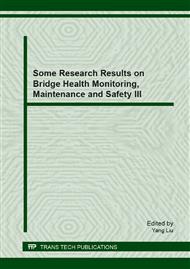p.31
p.43
p.53
p.67
p.77
p.85
p.95
p.107
p.117
Reliability Prediction of Bridges Based on Monitored Data and Bayesian Dynamic Models
Abstract:
Bridges are subjected to time-dependent loading and strength degradation processes. The main purposes of the designers and the owners are to keep these processes under control, to real-timely know and predict the structural time-variant reliability indices through health monitoring for bridge structures. The sensors of monitoring systems used in structural engineering provide data used for reliability prediction. But how to make use of monitored data to predict and make assessment of the time-variant reliability indices of bridges has become the bottleneck in the field of structural health monitoring (SHM). Bayesian dynamic models can combine the structural monitoring information with the structural reliability, and also can consider the uncertainty of the mass monitoring information. Therefore, in this paper firstly the bayesian dynamic model is built based on the monitoring information; secondly the monitoring mechanism of the monitoring information is given based on the built bayesian dynamic model; thirdly structural reliability indices are predicted based on the monitoring information and the built bayesian dynamic models; finally an actual example is provided to illustrate the feasibility and application of the built bayesian dynamic models in this paper.
Info:
Periodical:
Pages:
77-84
Citation:
Online since:
September 2013
Authors:
Price:
Сopyright:
© 2014 Trans Tech Publications Ltd. All Rights Reserved
Share:
Citation:


